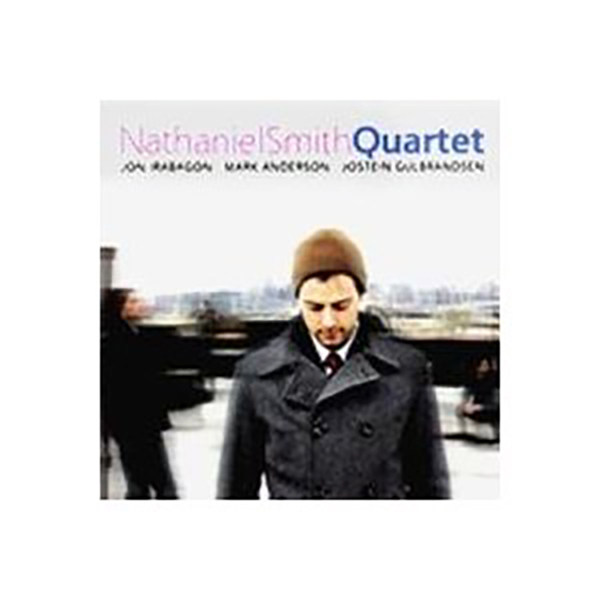
by Ian Mann
July 13, 2011
/ ALBUM
There's a quiet confidence about this record plus a high degree of musical sophistication.This album isn't one that shouts its presence but it speaks with intelligence and eloquence.
Nathaniel Smith Quartet
“Nathaniel Smith Quartet”
(Fresh Sound New Talent FSNT 371)
Any album featuring saxophonist of the moment Jon Irabagon is bound to offer something of interest and this is no exception. Irabagon, shortly to appear for two nights at London’s Vortex Jazz Club as a member of the band Mostly Other People Do The Killing adds his talents to this session led by drummer Nathaniel (Nate) Smith.
The album was released in 2010 and Smith forwarded me a copy earlier this year but the initial sessions date back to 2007 when Smith and Irabagon plus bassist Mark Anderson and guitarist Jostein Gulbrandsen were fresh out of college. The seven compositions (five by Smith, two by Gulbransen) had been thoroughly played in by the group before the recording and as a result there’s a quiet confidence about this record plus a high degree of musical sophistication. The interplay between Irabagon’s horn and Gulbrandsen’s guitar is particularly engrossing and Smith and Anderson handle the sometimes tricky rhythm parts with aplomb.
Irabagon introduces Smith’s “Daybreak and Then Dusk” but it’s Gulbrandsen who takes the first solo, gliding agilely above Smith’s quietly bustling cymbal work and Anderson’s anchoring bass before Irabagon takes over with his slyly probing sax ruminations. Smith’s notes acknowledge the influence of Dave Liebman’s composition classes on both this piece and the following “Tortoise Pendant”. Certainly both pieces are full of clever, complex, signature bending ideas with the opener meandering interestingly.
“Tortoise Pendant” is more focused, with a stronger narrative arc. Anderson again provides the rock as Smith chatters around the luminous, chordally sophisticated soloing of Gulbrandsen and the guitarist’s elegant exchange of ideas with Irabagon.
Gulbrandsen’s two contributions appear back to back and maintain the high standards set thus far. Smith notes that his colleague’s tunes “embody artistic maturity, saying a lot with a little”. The first “Return of the Bear” stays true to the already established “house style” and allows Irabagon and Gulbrandsen the chance to stretch out, the guitarist adopting a more forceful, rock influenced sound than that deployed previously.
“Tomorrow’s Perfume” is a minimalist ballad with surprisingly tender contributions from Irabagon and Gulbrandsen and delicately detailed drum work from Smith.
Smith’s “Actionable Intelligence” features an insistent drum groove, fluid bass lines and two effortlessly fluent Irabagon solos. Gulbrandsen’s solo sees the return of the urgent, biting, rock influenced tone first exhibited on his own “Return Of The Bear” but it’s the excellent Irabagon who stars here with the sheer intelligence and inventiveness of his playing.
“Travishamockery” is a twisted blues featuring Irabagon’s bleary sax lines and with Gulbrandsen sounding like a Metheny/Scofield amalgam. Bassist Mark Anderson, who displays intelligence and flexibility throughout, gets the chance to shine with a rare solo and doesn’t disappoint. There are also some inventive brushed drum breaks from leader Smith making this one of the most conventionally structured tunes on the album.
The closing “Shadow Puppet” exhibits the same laid back intelligence as the rest of the album with Gulbrandsen and Irabagon delivering clever but not bombastic solos above the quiet chatter of Smith’s drums and Anderson’s steadying bass pulse. There’s a brief section when sax and guitar drop out leaving Smith to provide splashes of understated percussive colour above Anderson’s implacable bass.
This album isn’t one that shouts its presence but it speaks with intelligence and eloquence. Smith and Gulbrandsen’s angular themes provide the framework for quietly rigorous improvisation. Gulbrandsen is new to me and is an interesting find with a guitar vocabulary that respects the tradition yet looks beyond it. It’s also interesting to hear the chameleon like Irabagon in yet another context, this is like an edgier version of his “The Observer” persona and very different to other aspects of his solo work. It’s also a long way removed from the studied irreverence of MOPDTK.
As for Smith himself he’s an intelligent composer and, as a glance at his blog shows, a deep thinker about jazz and its current role. He’s also a distinctive drum stylist who prefers to put the emphasis on subtlety rather than power. This eponymous début album deserves to bring his name to the attention of the wider jazz public. Smith also leads a trio featuring pianist Toru Dodo and bassist Aidan Carroll and is not to be confused with the other Nate Smith (drummer with Betty Carter, Dave Holland etc.).
COMMENTS
Thanks Ian! You’re too kind!
Nate Smith
blog comments powered by Disqus